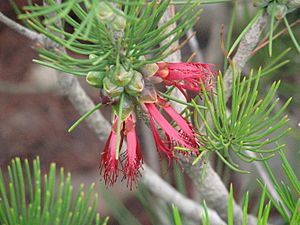Granite claw flower facts for kids
Quick facts for kids Granite claw flower |
|
|---|---|
 |
|
| Calothamnus graniticus subsp. graniticus in the Royal Botanic Gardens, Cranbourne | |
| Conservation status | |
| Scientific classification | |
| Genus: |
Calothamnus
|
| Species: |
graniticus
|
| Synonyms | |
|
Melaleuca granitica (Hawkeswood) Craven & R.D.Edwards |
|
The Calothamnus graniticus, also known as the granite claw flower, is a special plant. It belongs to the myrtle family (called Myrtaceae). You can only find this plant growing naturally in the south-west part of Western Australia. This means it is endemic to that area.
There are two slightly different types of this plant, called subspecies. Both of them are considered "near threatened," which means they could be at risk in the future. The granite claw flower is a shrub that grows upright and has a rounded shape. Its leaves look a bit like pine needles and are a dark, grey-green color. It usually has bright red flowers. One type, Calothamnus graniticus subsp. graniticus, grows in the Leeuwin-Naturaliste National Park. It is even the special flower for the nearby city of Busselton.
Contents
What Does It Look Like?
The Calothamnus graniticus is a shrub that grows straight up and is quite bushy. It can sometimes have many stems and reach about 2 meters (6.6 feet) tall. Its leaves are usually 40 to 80 millimeters (1.6 to 3.1 inches) long. They are shaped like a cylinder and get thinner towards the end, but they don't have a sharp point. These leaves are covered with short, white hairs, which makes them look a bit grey.
The flowers are usually a bright red color, but sometimes they can be cream-colored. They grow in groups or in uneven spikes, with 2 to 25 flowers in each cluster. You'll often find them on older parts of the plant where there are no leaves. The petals of the flowers are about 6 to 7 millimeters (0.24 to 0.28 inches) long. Inside the flower, the stamens (the parts that make pollen) are grouped into 4 bundles, like claws. Each bundle has 20 to 25 stamens. This plant usually flowers from May to August. After the flowers, it grows woody fruits called capsules. These capsules are almost cylindrical and are about 6.5 to 10 millimeters (0.26 to 0.39 inches) long and 7 to 10 millimeters (0.28 to 0.39 inches) wide.
How It Got Its Name
The plant Calothamnus graniticus was officially named in 1984 by a scientist named Trevor Hawkeswood. He wrote about it in a science magazine called Nuytsia. The second part of its scientific name, graniticus, tells us something important. It means that this plant always grows in soil that comes from granite rock.
There are two main types of this plant, called subspecies:
- Calothamnus graniticus Hawkeswood subsp. graniticus: This type has leaves that are about 1.5 millimeters (0.06 inches) wide. Its flowers grow in groups or spikes of up to 15 flowers. You can find this subspecies only around the Cape Naturaliste area.
- Calothamnus graniticus subsp. leptophyllus (Benth.) Hawkeswood : This type has thinner leaves, about 0.5 to 0.8 millimeters (0.02 to 0.03 inches) wide. Its flowers grow in groups or spikes of up to 25 flowers. This subspecies is found in the area between Dwellingup and Collie.
Where Does It Grow?
The Calothamnus graniticus plant grows in Western Australia. You can find it in and around the areas of Cape Naturaliste, Dwellingup, and Collie. This region is known as the Jarrah Forest biogeographic region. It likes to grow in sandy soils that come from granite rock.
Protecting the Plant
The Western Australian government's Department of Parks and Wildlife has given Calothamnus graniticus a "priority 4" classification. This means the plant is considered rare or "near threatened." It's important to protect these plants so they don't become endangered in the future.
Growing It at Home
The Calothamnus graniticus is a beautiful shrub that can be grown in gardens. It grows well in warm places and likes to be in a sunny spot. It's quite easy to grow new plants from its seeds. Once the plant is grown, it responds well to being trimmed, which helps it stay healthy and look good.


